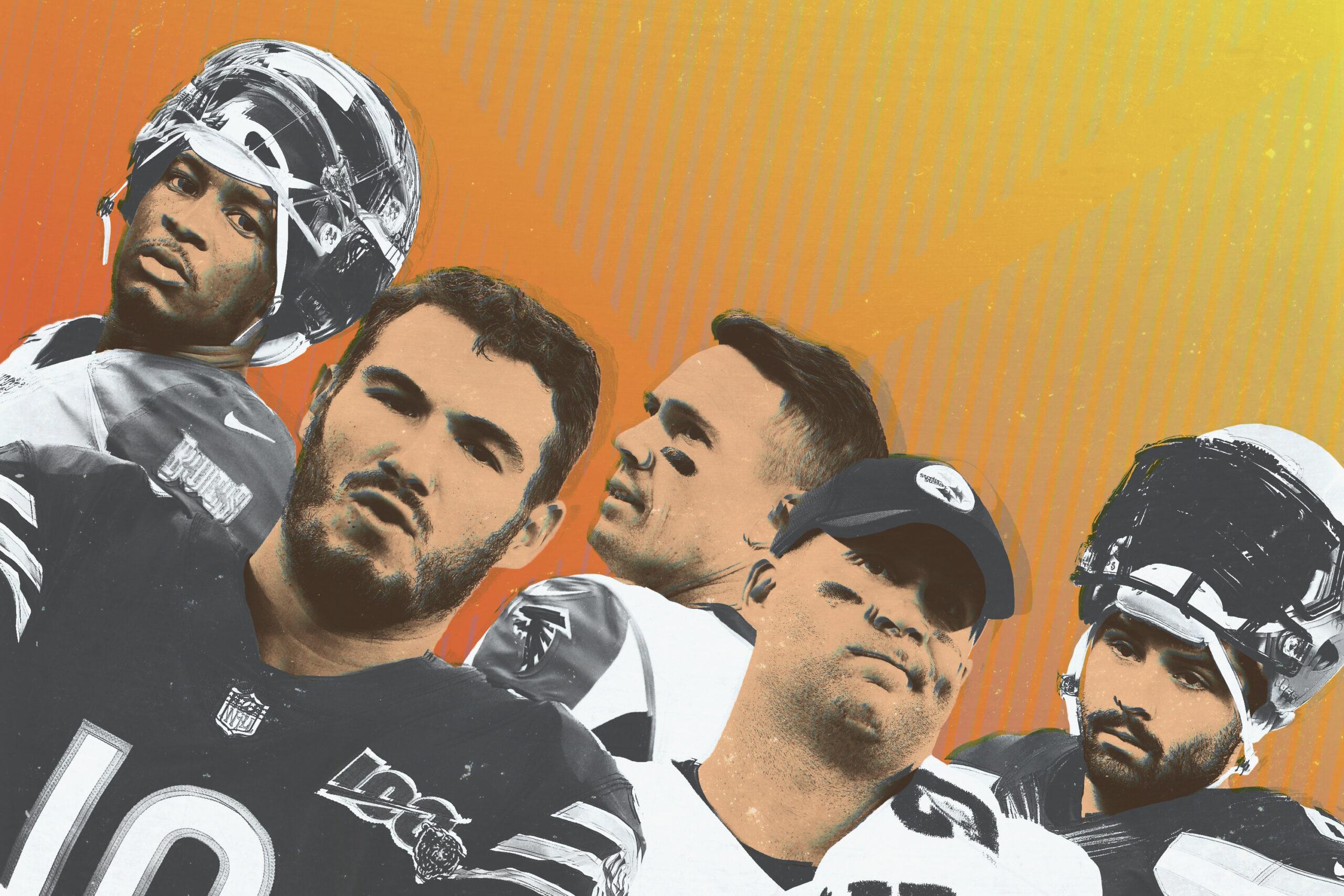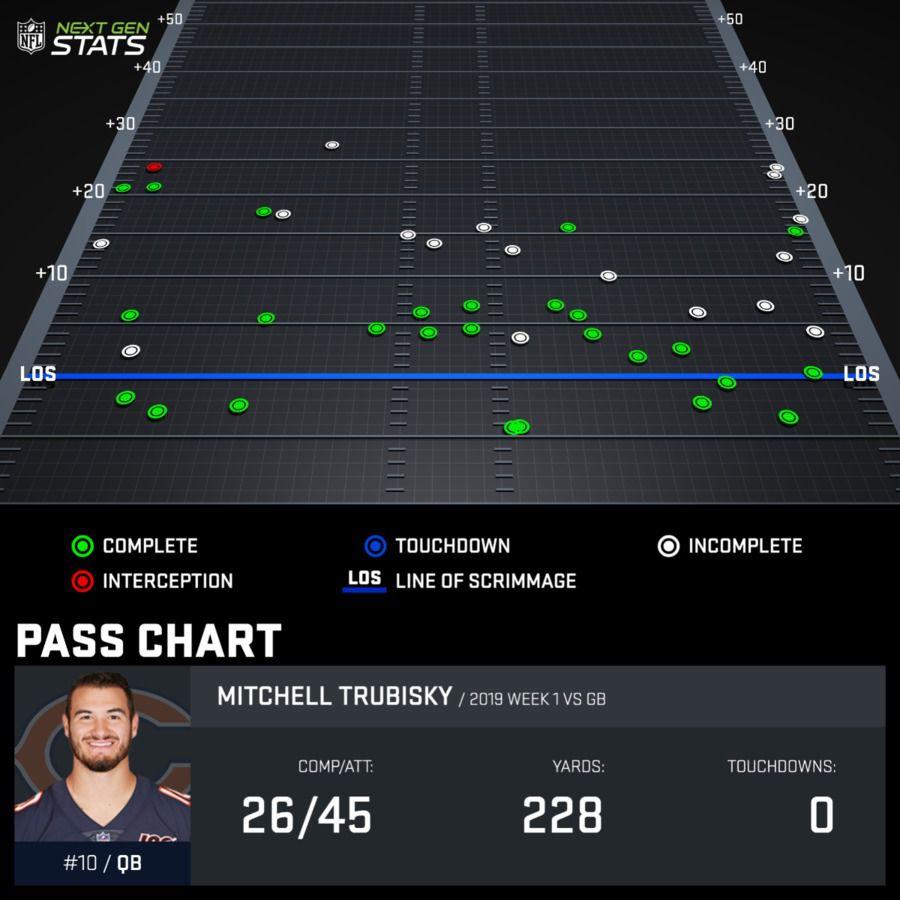
The 2019 NFL season got off to an exciting start, especially for the Vikings, Patriots, Ravens, Titans, and Cowboys—teams with offensive units that executed their respective game plans to near perfection. But while those efficient squads each got their seasons started off on the right foot, Week 1 brought various levels of disaster for a handful of other offensive groups: The Mitchell Trubisky–led Bears, the Odell Beckham Jr.–boosted Browns, the “no risk it, no biscuit” Buccaneers under Bruce Arians, the Dirk Koetter–coordinated Falcons, and the new-look Steelers all performed below expectations.
There are no sweeping conclusions to make off any one game, of course—particularly the season opener, when players are still knocking off the rust and trying to find some rhythm. But that doesn’t mean we can completely ignore the subpar offensive play from those five teams over the weekend. Let’s sort through each game and try to add a little context to the underwhelming numbers, and break down just how concerning each offense’s tepid performances were in Week 1.
Chicago Bears
Chicago’s three-point output at home against the Packers on Thursday was certainly not the start that head coach and play-caller Matt Nagy was looking for. The Bears may boast one of the most fearsome defensive groups, but the team really needs quarterback Mitchell Trubisky to make a big jump in his third season if they’re going to contend for a Super Bowl.
Trubisky, who may or may not be an ambi-thrower, was erratic with his accuracy and decision-making in the opener, and finished the game 26-for-45 (58 percent) for 228 yards with no touchdowns and a pick. His pass chart from Sunday does well to illustrate his limitations as a thrower:

Trubisky completed just four of 18 passes of 10-plus yards, per NFL Next Gen Stats, and leaned heavily on dink-and-dunk options underneath. While Trubisky did find Allen Robinson on a couple of deeper developing routes, he also forced a few passes into coverage early in the game that should’ve been picked, and then tossed a back-breaking interception from the 16-yard line with 2:03 to go and the Bears trailing 10-3 in the fourth quarter. It was a bad throw and a bad decision—an unnecessary prayer that he threw into double coverage.
Of course, the Bears’ struggles weren’t all Trubisky’s doing. Even though it remained a one-score contest throughout, Chicago was forced to go pass heavy (Trubisky dropped back on 53 of the team’s 65 offensive plays) as the team’s run game—which was paced by Mike Davis (five rushes, 19 yards) and rookie David Montgomery (six rushes, 18 yards)—failed to find its footing against a stout Green Bay front. Chicago finished with just 46 rushing yards on 15 carries.
Trubisky was regularly on the run from the Packers’ hounding pass rush, too. The third-year quarterback was pressured on 21 of his 53 dropbacks, a 39.6 percent rate that ranked seventh worst on the week, per PFF. He struggled miserably in those situations, completing just six of 15 attempts, tossing an interception, and taking five sacks to notch a passer rating of 20.1 under pressure for third worst among qualifiers in the 16-game slate. He wasn’t much better from a clean pocket, either: He completed 20 of 30 passes for 185 yards on those dropbacks to register an 83.3 passer rating, good for 20th among 26 qualifying passers.
With no run game, too much pressure, and an underwhelming clean-pocket performance from Trubisky, the Bears were consistently off schedule. As Nagy said after the game, the team “lived in that third-and-7, third-and-8, third-and-9 world.” That makes it tough for any quarterback and any offense to consistently string together drives. The Bears finished 3-for-15 on third down and 0-for-2 on fourth-down opportunities, and came out of the 10-3 loss with just 254 yards of offense on 65 plays (a 3.9 yard average).
Concern Index: It’s Getting Harder and Harder to Rationalize This
For those hoping that another offseason of immersion in Nagy’s offense and playbook would help Trubisky get off to a fast start, this game was a massive disappointment. Trubisky looked out of rhythm from start to finish, sailing passes and forcing balls into coverage. Packers corner Tramon Williams issued a devastating summation of Green Bay’s strategy after the game: “We knew if we could make [Trubisky] play quarterback, that we’d have a chance.” Ouch.
Trubisky’s athleticism makes him dangerous as a runner, but for this offense to take the next step, Chicago needs its former second overall pick to speed up his processing and deliver passes with more accuracy and better timing. It’s a long season, but in Week 1, there was very little sign that that’s close to happening. It could hamstring this group all year.
Cleveland Browns
The Browns carried an immense amount of hype into Week 1, thanks to the team’s strong finish last year under then-rookie Baker Mayfield and their acquisition of superstar receiver Odell Beckham Jr. during the offseason. But that group failed to launch on Sunday against the Titans and lost in an embarrassing blowout, 43-13. Mayfield, who finished 25-for-38 for 285 yards, one touchdown, and three untimely fourth-quarter picks, clearly wasn’t at his best, but was his performance as bad as it seems?
For starters, the Browns ground game was effective. The offensive line finished with the eighth-best run-blocking grade per PFF (70.7), and Nick Chubb, D’Ernest Johnson, Jarvis Landry, and Dontrell Hilliard combined for 102 yards and one touchdown on 20 carries—an average of 5.1 yards per attempt. And despite what was clearly a subpar performance from the air attack, Cleveland was well within striking distance of Tennessee late into the third quarter: When Mayfield found David Njoku for a 3-yard touchdown strike with 2:13 to go in the third frame, it cut the Titans’ lead to 15-13. At that point, Tennessee’s win probability was a modest 57.7 percent.
But that’s when things spiraled out of control for the Browns. Tennessee came back and on the very next play, Derrick Henry took a screen pass 75 yards to pay dirt, pushing the Titans’ lead back up to 22-13. Mayfield started forcing the issue far too much from that point on: He tossed picks on three of the team’s next four possessions, and that was all she wrote for the Browns in Week 1.
Concern Index: No Need to Panic … Yet
Mayfield’s decision-making absolutely must improve if Cleveland’s offense is going to live up to its hype, but a handful of the issues that cropped up throughout the game should be fixable. For starters, the team’s offensive line gave up far too much pressure and surrendered five sacks, or 11.6 percent of Mayfield’s dropbacks (for reference, he was sacked on just 1.9 percent of his dropbacks in the final nine games of 2018). It didn’t help that left tackle Greg Robinson was ejected for kicking a Titans player in the head, but head coach and play-caller Freddie Kitchens was quick to take the blame for not dialing up more quick-hitting pass plays to get the ball out of Mayfield’s hands sooner. That strategy was a crux for the team’s offensive explosion last season, and something the offense can focus on in Week 2.
The other major issue that kept Cleveland behind the eight ball was a deluge of penalties. As a team, the Browns racked up 18 penalties, nine of which came from the offense (for a loss of 86 yards). Combined with the pressure up front, those penalties meant the Browns were playing behind the chains almost constantly throughout the game. Cleveland faced two third downs of 13 yards, one of 16 yards, two of 18 yards, one of 26 yards, and another of 28 yards. One of Mayfield’s interceptions came on a second-and-14 that followed a holding call on first down.
The team can better stay on schedule with a little more discipline and more plays designed to beat pressure and get the ball out quickly. I expect Kitchens, Mayfield, and the Browns to adapt in Week 2 and bounce back on Monday Night Football against the Jets.
Tampa Bay Buccaneers
Apart from Chris Godwin’s continued breakout and some surprising explosiveness from second-year running back Ronald Jones II, there wasn’t a whole lot to feel good about after Tampa Bay’s sloppy 31-17 loss to the 49ers at home. Jameis Winston, playing for the first time under new head coach and renowned quarterback whisperer Bruce Arians, looked exactly the same as he’s always looked. Winston was scattershot with his accuracy and frenzied in his decision-making, and he tossed three crippling interceptions—two of which were returned for touchdowns.
One of the picks wasn’t really Winston’s fault; it careened off tight end O.J. Howard’s hands and into the waiting mitts of a defender. Another—Richard Sherman’s pick-six—was partly due to a bad route by Peyton Barber. But instead of demonstrating much-needed discipline, the fifth-year veteran showed few signs he’s ready to give up the far-too-aggressive style that’s made him a turnover machine throughout most of his career. He also fumbled the ball twice and nearly threw a fourth interception that was dropped. Winston finished with 194 yards passing and one touchdown on 36 attempts, good for just 5.4 yards per attempt and a 45.4 passer rating.
He didn’t get a whole lot of help, either. Mike Evans was mostly ineffective coming off an illness and finished with just two catches for 28 yards. Howard failed to live up to the preseason hype, causing one interception and losing a fumble deep in San Francisco territory before ending the game with four catches for 32 yards. In all, the Bucs fumbled three times (losing one of those), and right tackle Demar Dotson wiped out two Cameron Brate touchdowns on the same drive with devastating holding calls.
Concern Index: This Already Feels Like a Bad Case of Déjà Vu
Turnovers were a massive problem for the Buccaneers offense in 2018. The team led the NFL with 35 giveaways, including a league-high 26 interceptions, and that careless playing style doesn’t seem to have gone away. Everything starts and ends with quarterback play, and unless Winston can prove he can play with more consistency and discipline, Tampa Bay will have a hard time finding a new identity in 2019.
Atlanta Falcons
Dirk Koetter’s return to his role as the Falcons offensive coordinator got off to a slow start against the fast and physical Vikings defense. Minnesota’s defensive line gave Atlanta’s new-look offensive line—an overmatched group that had rookie first-rounders Chris Lindstrom and Kaleb McGary starting at right guard and right tackle, respectively—fits by stifling the Falcons run game, ruining Devonta Freeman’s return, and sacking Matt Ryan four times while keeping him on the run from start to finish.
Ryan finished 33-for-46 for 304 yards and tossed two garbage-time touchdowns and two picks. Atlanta didn’t get on the board until the fourth quarter, when Minnesota already led 28-0 and had the game under control. The Vikings dominated.
Concern Index: I Was More Worried About the Team’s Postgame Tweet Than Its Offensive Performance
It’s far too early to count out a talent-packed and battle-tested offense led by Ryan, a former MVP, after an opening-week dud on the road. The team, which lost Lindstrom to a foot injury and rotated McGary with veteran Ty Sambrailo through the game, will need to shore up its offensive line group and strategize ways to get Ryan better protected, but if Atlanta can cut down on the back-breaking turnovers (the Falcons finished minus-three in that category on Sunday), it’ll be fine. The Falcons get a chance to right the ship next week at home against the Eagles.
Pittsburgh Steelers
The Ben Roethlisberger–led Steelers got off to a slow start on the road against a tough defense, and the Patriots took advantage. Roethlisberger struggled to find a rhythm with his receivers, completing 27 of 47 passes for just 276 yards (5.9 yards per attempt) and a pick to notch a 65.6 passer rating.
The team’s run game was equally ineffective: James Conner rushed 10 times for 21 yards and backup Jaylen Samuels added 4 yards on two carries. Pittsburgh failed to extend drives on three consecutive possessions in the second quarter, and came up short on two third-and-1s and another on fourth-and-1. Pittsburgh picked up just three first downs and gained 87 yards in the first two frames and went into halftime down 20-0. They didn’t find the end zone all night in the 33-3 loss.
Concern Index: I’ll Give Them a Mulligan
The Steelers’ pass-catching corps outside of JuJu Smith-Schuster (six catches for 78 yards) mostly struggled to get on the same page as Big Ben. Free-agent addition Donte Moncrief converted his 10 targets into three catches for 7 yards and tight end Vance McDonald was less of a focal point of the scheme than many had projected, catching two of four targets for 40 yards. On the other hand, second-year pro James Washington was a bright spot and reeled in a 45-yard bomb in the third quarter, and rookie Diontae Johnson grabbed three balls for 25 yards. The passing-game hierarchy feels fluid right now, and the team could benefit from a shake-up that gives its young playmakers bigger roles.
As I did with the Falcons, I’m willing to give the Steelers the benefit of the doubt considering they started the year on the road against a very tough defense. But if we see a repeat performance against a Seahawks defense that surrendered 418 passing yards to Andy Dalton (a career high for the Bengals passer) in Seattle last week, I’ll start getting worried.

